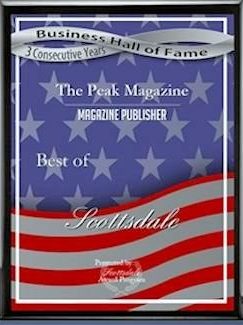Winner, Seeing and Doing Category, 2015 Summer Fun Write Stuff Contest
By Kraig Randal Nelson
The Desert Foothills has lost her historical doyenne. Mrs. Frances C. Carlson, author of Cave Creek and Carefree, A History of the Desert Foothills, passed on June 24, 2015. Her important book, published in 1988, was the definitive resource for anyone interested in Cave Creek or Carefree history from the canal-building, prehistoric Hohokam to the ingenious Carefree developer’s Tom Darlington and K.T. Palmer in the 1960s.
One issue in Carlson’s book remained unanswered, and that was the source of the name of Cave Creek’s first post office, called Overton. The first permanent Anglo settlers in the area were Jeriah and Amanda Wood. They settled near the creek, named Cave Creek by the U.S. Army in 1866, near today’s Rancho Manana Golf Resort. Jeriah and Amanda Wood established Cave Creek Station in 1877 and by 1880 the first post office in the area was established. Mrs. Carlson states in chapter three,”Jeriah Wood’s little station began to take on a busy, prosperous air…he supplied the needs of passing travelers and sold beef and milk to the nearby [mining] camps. In the fall of 1880, his station became a post office and he took on the duty of postmaster. For reasons lost to history, this first post office at Cave Creek Station was named Overton.”
I have a hypothesis which may solve this enigma. It involves the fact Cave Creek Station was in an area replete with an abundance of Hohokam artifacts and irrigation canals (ditches) according to today’s archaeologists. It involves one of the entrepreneurial founders of the towns of Phoenix and Cave Creek, William B. Hellings. And finally, it involves an Arizona county that no longer exists. Let’s put the puzzle together.
Think of the shape of the state of Nevada. As it tapers to a southern point, most of which is now called Clark County, includes a town called Overton (also includes the entertainment mecca called Las Vegas). Overton, Nevada (north of Lake Mead) was settled in 1869. In the 1880s, it was the location of the only store in the area called Moapa Valley; it was also the location of a plethora of ancient Native American artifacts and petroglyphs. In Overton today, one may find the “Lost City Museum.” The museum’s emphasis is on the Native Americans who thrived in the area from A.D. 300 to A.D. 1200; archaeologists now identify the group as Ancestral Puebloans (formally Anasazi). This situation sounds strikingly similar to Cave Creek Station. Could there be a correlation? Overton was in Nevada, or was it?
Originally, Overton was in Arizona! Almost the entire southern “tip” of Nevada was a part of Arizona; now called the “Lost County.” Pah-Ute (Paiute) County, as it was known, existed from 1865 until 1871. When the United States Congress approved legislation to transfer this property to Nevada there was an Arizona firestorm of contention, albeit fruitless. I would suggest that Jeriah and Amanda Wood became aware of this area, including Overton, from the knowledgeable and influential William B. Hellings.
Mr. Hellings owned and farmed two sections of land near the Salt River. He eventually built an extremely prosperous flour mill; this area, just a few miles from the original Phoenix townsite, became known as Mill City. In 1873, Mr. Hellings hired fifty men to build Cave Creek Road and started purchasing mines in the Cave Creek area. One mine was called Continental Mine, and is the namesake of Continental Mountain. Mrs. Carlson tells us he intended to establish Cave Creek Station, but he didn’t. Did he communicate with Jeriah and Amanda Wood and influence them to move forward with this idea? I believe he did because his neighbor in Phoenix was Josiah Wood, Jeriah’s brother. Did they discuss the “Lost County” and Overton’s similarities to Cave Creek Station? It would be quite a coincidence if they didn’t. I guess we’ll never really know.
Thanks to the Cave Creek Museum and the Desert Foothill Land Trust, the history and the land encompassing Cave Creek Station will be preserved in perpetuity for appreciative future generations; the memory of Mrs. Frances C. Carlson, and her invaluable legacy, is unquestionably well worth preserving as well.



























Recent Comments